by Editor | Dec 23, 2013 | Food
By Elena del Valle
Photos by Gary Cox
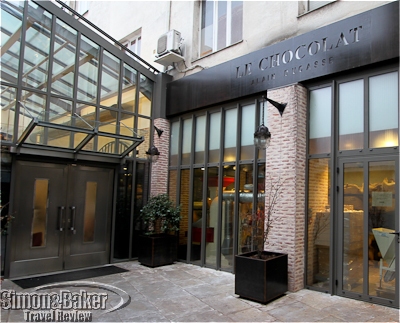
The courtyard outside Le Chocolat Alain Ducasse Manufacture a Paris
The heady odor of chocolate was the first thing I noticed as we entered the Le Chocolat Alain Ducasse Manufacture a Paris, Manufacture for short, on a commercial street in Paris, France. Located in one of the city’s lesser known (to tourists) east neighborhoods the Manufacture, 320 square meters in size, was a modern chocolate factory in the back and a gourmet chocolate shop in the front. We left our winter coats behind and donned special white coats to enter the inner sanctum where the master chocolate maker and a handful of young men worked in harmony.
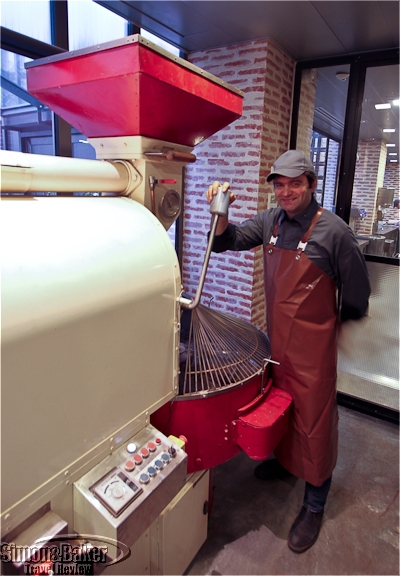
Nicolas Berger roasting cocoa beans
On a chilly morning, Nicolas Berger, the master chocolate maker, welcomed us warmly in the roasting room. For a short while he explained the process that transformed the raw cocoa beans from exotic locations across the globe into distinctive gourmet chocolates that stood out for their unique flavors in a city where a myriad shops sell fine chocolates. Prior to launching the Manufacture, Berger worked at Payard in New York City. He then joined the Alain Ducasse company as pastry chef at the Essex House also in New York. He later became executive pastry chef at the Restaurant Alain Ducasse at the Plaza Athenee hotel in Paris, France. Before that, he worked at Jean-Paul Hevin, Laduree, and Pierre Herme in France.
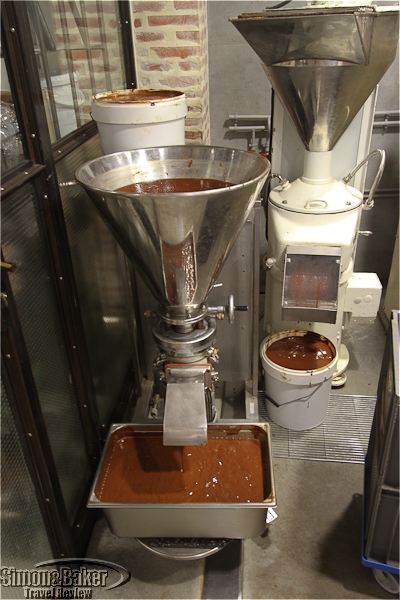
We watched chocolate being blended, smoothed and processed between roasting and the final product
He showed us the specialized equipment sourced with patience and effort and made in several countries: France, Germany, Italy and Switzerland. While we watched, he poured a container of 25 kilos of Madagascar cocoa beans into the toasting machine which processed 50 kilo batches at a time. A tiny amount of water was included in the process, he explained. The steam it produced killed any germs.
Bags of cacao beans marked with their country of origin stood like sentinels on the other side of the small room. A glass wall made it possible for customers to see the roasting room as they entered the courtyard that led to the boutique.
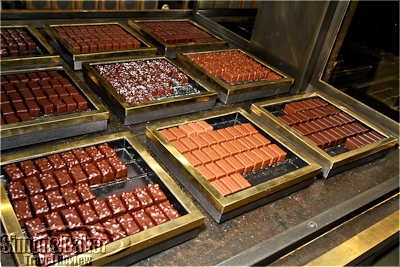
Trays of finished chocolates were displayed in the showroom
Following the roasting and separation of the shells and the beans in the roasting room the cocoa bean process continued in an adjacent area. The pure cocoa liquid went through several machines to be refined and blended with other ingredients, such as organic and biodynamic sugar from Brazil, and milk, depending on the outcome desired, into just the right consistency until eventually it was ready to be made into gourmet chocolate products. The initial refining process required about fifteen hours whereas the conching part of the process, which removed the thick gravely aspects, required at least twenty-four hours.
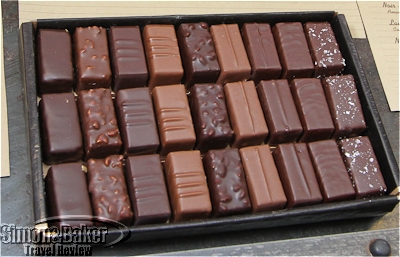
Fillings were coated, with great care, with a thin layer of chocolate
A variety of fillinging ran through an automated assembly line where each bite size morsel was coated with liquid chocolate. At the end of the line, staff removed the delicate product and prepared it for sale. Twenty-five flavors of individual chocolates were on offer. Production for December was expected to reach five or six tons. Nine staff, five in production and four in the shop, worked at Manufacture. While that might be a tiny amount in the chocolate industry where giant multinational companies produce huge quantities for commercial use and retail sale, it was the quality of the chocolate that we found impressive. We also appreciated being able to taste the classic single morsels of chocolate with filling in the place where they were made. More interesting at a personal level, was the variety of single source pure chocolates and how different the flavors where from each other.
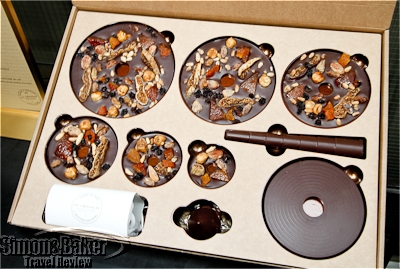
The shop offered a seasonal chocolate tree kit for the holidays
In the spotless shop, a central temperature controlled case with multiple glass covers that were operated by the staff was home to individual pieces of chocolate in a variety of flavors such as lime, praline, tonka bean and vanilla. As we selected the flavors we wanted to sample a staff person carefully removed one piece at a time and placed it on a ceramic plate.
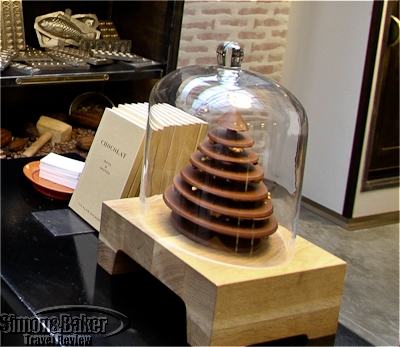
The tree was available in dark or milk chocolate. It could be assembled with the fruit and nuts facing up or down.
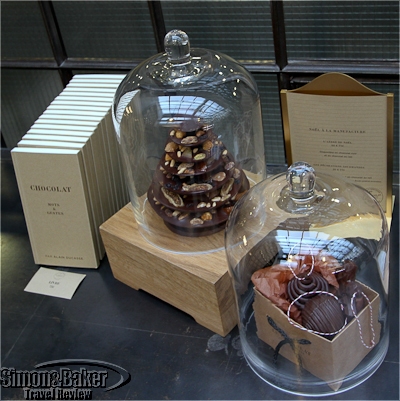
Left to right: The dark chocolate tree with nuts and fruit facing up and eatable dark chocolate Christmas tree ornaments
Along the left wall, there were sealed paper envelopes of single flavor chocolate bars from a variety of places of origin including Mexico, Peru and Venezuela, home of the well known Porcelana; Dominican Republic, Ecuador, Ivory Coast, Java, Madagascar, Sao Tome, Tobago, Trinidad, and Vietnam, all selected with care and emphasis on the quality of flavor (although the company made it a point of purchasing only cocoa beans harvested under fair labor practices), Berger explained with much enthusiasm.

The five single origin chocolate bars we sampled
The most popular single origin chocolate bar flavors were Porcelana du Perou 75 percent, Mendiant Almonds & Fruits dark chocolate and Perou non conche. A few days after our visit, we tasted five single origin chocolate bars of the 26 flavors available: Madagascar 55 percent milk chocolate, Madagascar 75 percent Ferme Bejofo Criollo chocolate, Peru 75 percent Trinitario, Sao Tome 75 percent Forastero Ameldonado, and Tradition Peru 75 percent non conche. We were surprised at how different the flavors were. In some ways, this chocolate tasting reminded us of a wine tasting. There were aspects of each bar we liked and subtle yet notable variations between the chocolates. Even the shade of the chocolate bars varied.
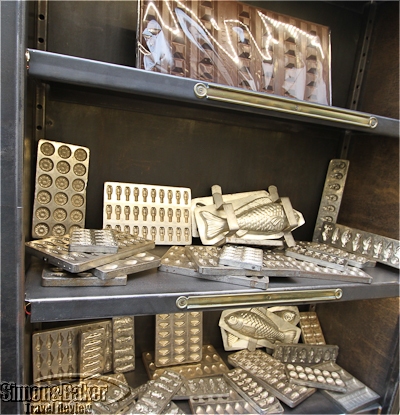
Chocolate and molds on display in the shop
While the Madagascar milk chocolate was smooth the dark chocolate from the same country had a hint of bitter and a slightly acid aftertaste. We thought there was a mild berry flavor in the Peru Trinitario which left a dry aftertaste. The Sao Tome had a rich, smoky flavor and a dry aftertaste as well. The non conche Peru bar was the most distinctive. Conche is a mixer and agitator that distributed cocoa butter within chocolate. Because that chocolate had not gone through the conching process it had a gritty texture. The flavor was full with dark and tart finish. One of us liked it especially while another liked it the least.

The interior of the shop
The nuanced flavors of the bite size chocolates are now fading in my memory. Fortunately, some chocolate bars survived the tasting. I will enjoy then while they’re still fresh and plan to revisit the shop at the next opportunity. When I’m in Paris again I’ll make a point of stopping by the shop to sample some of the flavors I didn’t have time to try and taste the ones I liked especially once again. As I think about it I liked all of the chocolate bar flavors so I may have to start from scratch. Le Chocolat Alain Ducasse Manufacture a Paris, 40, rue de la Roquette 75011 Paris, France, +33 1.48.05.82.86, http://www.lechocolat-alainducasse.com/en
by Editor | Dec 9, 2013 | Attractions, Ecotourism, New Articles
Article and photos by Laura Scheiber
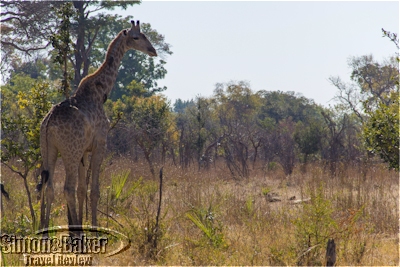
A giraffe keeping vultures away from her baby
For me, an ideal vacation includes a little rest and relaxation mixed in with adventurous activities. Perhaps this was why my stay at Tongabezi Lodge along the mighty Zambezi River in Zambia was so memorable. On the day of arrival at this luxury lodge, I met with Quentino Mbingi, the director of activities, who invited me to choose from a handful of activities ranging from the adrenaline pumping thrill of sitting on the edge of Victoria Falls to relaxing on a sunset boat cruise on the Zambezi River with sundowners. Quentino efficiently put together an itinerary that allowed me to partake in all of my preferred activities during my three day stay. Most activities were included in the room rate, along with meals, and drinks. Some activities offered by outside companies were available for an additional fee.
On my first day, I enjoyed a two hour sunset cruise on the beautiful Zambezi River. Four other guests and I hopped into a small motor boat on the dock at Tongabezi with Captain Victor, a soft-spoken friendly man who pointed out the many birds we observed along the bank. We meandered around a small island in the middle of the river, and Captain Victor positioned our boat within a few feet of crocodiles sunbathing on the sandbar. Without warning, one of the big crocodiles splashed in the water at lightening speed. I had quite the adrenaline rush. I would have felt scared if I hadn’t been in such good hands.
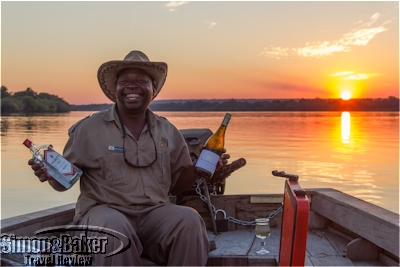
Captain Victor serving up sundowners
While stopping for sundowners in the middle of the river and watching the magnificent sunset, Captain Victor explained that he was a well-known crocodile hunter who had caught hundreds of crocodiles in his lifetime and set them free further down river away from human populations. I liked hearing his fascinating stories about crocodile (and snake) hunting while drinking a refreshing South African Sauvignon Blanc on the Zambezi River.

A crocodile sunbathing on the river bank
The next day I went on a private game drive in Mosi-Oa-Tunya National Park, the second smallest in all of Zambia, and roughly 20 minutes from Tongabezi. I had hoped to see a rhinoceros since it was the only one of the Big Five that I had not seen during previous safari adventures in Zambia. My private gaming guide, Fabias, provided clear and interesting explanations of the animals we saw while stopping anytime I wanted to take pictures. Most memorable was when Fabias spotted a number of vultures flying high in the sky. He drove to where they were circling and a few minutes later, he spotted a giraffe in the distance herding a bunch of vultures on the ground. Curious to find out what was going on, he drove closer to the giraffe where we eventually saw a young giraffe that had died sometime within the previous 24 hours, according to Fabias. Though sad, we couldn’t help but watch the mother giraffe valiantly try to keep the vultures away from her baby.
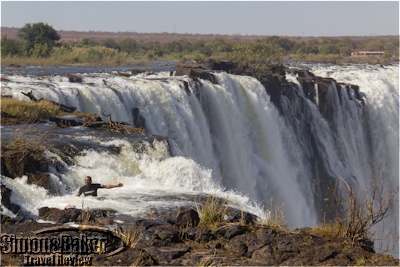
My guide demonstrated where I should sit at the edge of the falls
After a two-hour game drive, Fabias drove me to the five-star Royal Livingstone Hotel where the management of Tongabezi surprised me with a complimentary gourmet lunch and tour of Livingstone Island, which departed from the Royal Livingstone. I, along with seven other guests, was chauffeured by motorboat to the island where, our tour guide, Collins, took us on a five-minute walk to the side of the island facing Victoria Falls. He offered wetsuits to those of us interested in sitting in the natural pools in the Zambezi River on the edge of the Falls. Our fearless leader walked us toward the edge that had a heart-pounding drop of 100 meters. The views were spectacular and we were treated to a double rainbow. Collins carefully led three of us, one by one, into the water where we sat about 15 feet away from the edge of the Falls. Scary? Yes. Exhilarating and unforgettable? Absolutely. After such an adrenaline pumping experience, we were served a delicious lunch of fresh green salads, couscous, fresh tilapia fish, grilled vegetables, and a sweet bread pudding as a dessert. A South African white wine went well with the fish.
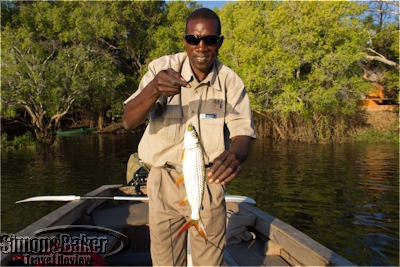
The tiger fish I caught with Fabias
After we returned to Tongabezi, Fabias prepared a small motorboat for my private fishing excursion. It was a lovely late afternoon with ideal temperatures and a cloudless sky, perfect for a relaxing boat ride on the Zambezi River. Fabias patiently showed me how to work the fishing rod and explained Tongabezi’s catch and release fishing policy. Within minutes, I felt a tug on my fishing line and excitedly reeled in a tiger fish. Fabias took care of the not so pleasant task of unhooking the fish. Throughout the trip, I enjoyed sundowners of my choice and opted for a refreshing South African Sauvignon Blanc. The hour and a half fishing trip ended with a beautiful sunset. At the end of a day full of activities, I was pleasantly surprised to find a bottle of sparkling wine in a bucket of ice, and a candlelit hot bubble bath waiting for me in my room, compliments of Tongabezi.
My final river adventure was a private canoe trip. Quentino, a certified river guide, went over the safety rules and helped me into a small canoe, while Captain Victor was in a motorboat ahead looking out for crocodiles and hippos. Quentino welcomed me to paddle, but made it clear that it was not necessary if I preferred to relax and take in the tranquil scenery. After crossing the river towards the Zimbabwe side, Quentino pointed out a number of colorful birds that were fishing along the riverbank. On our way back to Tongabezi, we canoed through some reed-covered islands where hippos were resting on sandbanks about 50 feet away from us. It was exciting to be so close, but I was happy to keep a distance, as I knew how fast hippos could move. Between Captain Victor and Quentino I felt in good hands, as both had had years of training and experience as river guides.
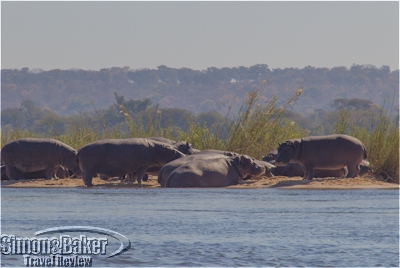
Hippos sunbathing during my canoe trip
The only downside of my stay at Tongabezi Lodge was that it ended too soon. The location of this luxury lodge was ideal. Just 40 minutes upstream from the hustle and bustle of Victoria Falls, the lodge was close enough for activities associated with the UNESCO world heritage site, while far enough to explore the Zambezi River. Having an activities director who customized my itinerary added a personal touch that set Tongabezi apart from other lodges. The service was top notch and I plan on returning someday to partake in the activities I did not include during this first visit.
by Editor | Dec 2, 2013 | Attractions, Ecotourism, Luxury Travel
Article and photos by Laura Scheiber

A double rainbow over Victoria Falls
During a trip to Zambia, I visited Victoria Falls, a UNESCO world heritage site forming part of the border of Zambia and Zimbabwe. Powered by the mighty Zambezi River, the falls are over 1,700 meters in width, and an impressive 100 meter drop. The Falls are known in the local language as Mosi-oa-Tunya meaning The Smoke that Thunders. I was in awe at the spray that loomed above this geographic wonder that has bragging rights to the greatest sheet of falling water in the world. One of the Seven Natural Wonders of the World, I anticipated it to be beautiful, but Victoria Falls was beyond my expectations in terms of size, strength and magnificence.
To get to Victoria Falls, I took a one hour flight from Lusaka to Livingstone within Zambia. I stayed at Stanley Safari Lodge, a luxury lodge tucked away on a hillside in the African bush, just a ten minute drive from the falls.
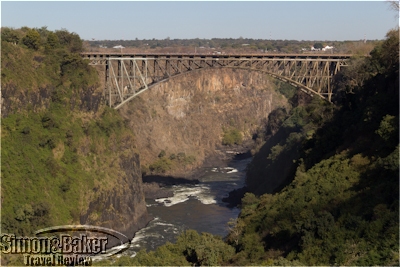
The bridge connecting Zambia and Zimbabwe
To enter Victoria Falls, I had to register at an entry point. International guests at the time of my visit in June 2013 had to pay a fee of $20. Luckily for me, the staff at my lodge arranged day and night walking tours with a private guide, Effeso Hammabola, who helped me navigate through the entry process.
Since I happened to be visiting during a full moon, I had the opportunity to do an evening Luna Tour. The highlight was seeing a rainbow at night, illuminated by the moon above the falls. We stopped at four different viewing points along the man made walkway on the edge of the falls during the hour long tour. I was amazed at how close we could get to the bank of the river just before it spilled over the edge.
Though I enjoyed the evening tour, I much preferred my day visit when I could fully appreciate the beauty and impressive size of the falls.

Effeso Hammabola, my Victoria Falls guide
Thanks to the proximity of my accommodations I was the first guest to arrive and finished up my two hour tour before hoards of tourists entered the site. Starting at the bank of the river, Effeso and I followed the walkway that had numerous lookout points from different angles, including the side of the falls, directly facing the falls and views of the Zimbabwe side where we could see a series of gorges. It was a pleasant pathway with many trees and greenery surrounding it.
I visited at the end of June, which was an ideal time because there was still an impressive amount of water in the Zambezi River that powered the falls yet the water flow wasn’t so strong that the amount of spray made it difficult to see, which happens, I was told, during the wet season.
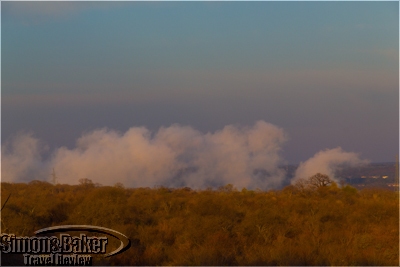
Spray from Victoria Falls
Overall my trip to the area was an unforgettable experience due to the awe inspiring size, incredible force and utter beauty of Victoria Falls. I would recommend a trip to friends and family who are interested in geographic wonders. I also would return to Stanley Safari Lodge to steer clear of the urban hustle and bustle of Livingstone while remaining close enough to the falls in the early morning hours.





























